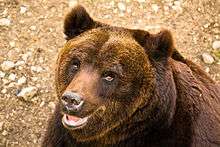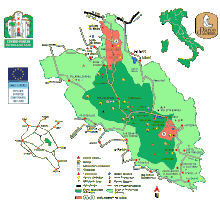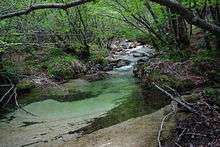Marsican brown bear
The Marsican brown bear (Ursus arctos arctos,[2] formerly Ursus arctos marsicanus), also known as the "Apennine brown bear", and orso bruno marsicano in Italian, is a critically endangered[1] population of the Eurasian brown bear, with a range restricted to the Parco Nazionale d'Abruzzo, Lazio e Molise, and the surrounding region in Italy. The Marsican brown bear differs slightly from other brown bears in its appearance and hibernation techniques.
| Marsican brown bear | |
|---|---|
 | |
| Scientific classification | |
| Kingdom: | Animalia |
| Phylum: | Chordata |
| Class: | Mammalia |
| Order: | Carnivora |
| Family: | Ursidae |
| Genus: | Ursus |
| Species: | |
| Subspecies: | U. a. marsicanus / arctos |
| Trinomial name | |
| Ursus arctos marsicanus / arctos Altobello, 1921 | |

With their existence dwindling, the Italian government has recently begun to stress their conservation. The park has become a sanctuary dedicated to animals such as the Marsican brown bear, with hopes of rekindling the large, yet isolative bears’ once-thriving existence. In recent years, more conservation groups have tried to help this bear. Debate exists as to whether it should be considered a subspecies or a taxon of its own.[3]
Characteristics/biology
The Marsican brown bear lives its life in isolation and their numbers are dwindling, with 50 bears remaining in the Parco Nazionale d'Abruzzo, Lazio e Molise. They have characteristics that differ from other brown bear subspecies. The Marsican brown bear, otherwise known as the Apennine brown bear, has a relatively calm temperament, with no aggression shown towards humans. In terms of size, the male Marsican brown bear is larger than most of the other brown bear subspecies, with a weight of around 217 kilograms (478 pounds), while the female is significantly smaller, at around 140 kilograms (310 pounds). These bears are known to be omnivorous in nature, mainly eating berries, while occasionally eating small animals such as chickens and other livestock. All of these traits the bear shows can likely be attributed to its existence in isolation. Baby Marsican brown bears tend to grow up fairly quickly. In a standing position, the Marsican brown bear can reach heights of up to two metres. Their large size, as well as noticeably different forepaws to their rear are characteristics that help distinguish their presence. The footprints, hair residue, colour of faeces, and claw marks the bears leave are special to their species. These large mammals have been spotted rolling rocks over in search of insects as well as reaching high into branches looking for berries, honey, etc. Their great sense of smell makes up for their mediocre eyesight when it comes to searching for food. A unique characteristic of the Marsican brown bear is that their winter hibernation is not made up of a single consecutive slumber. The bear wakes at times, which makes their official resurgence less lethargic. Through the years, the Marsican brown bear became the symbol of the Parco Nazionale d'Abruzzo, Lazio e Molise and lent its name to pan dell’orso (bear bread) and other traditional regional foods. Thanks to its presence, ecotourism improved in the whole Abruzzi region, though conflicts with shepherds and honey farmers are still reported. In prehistoric times, hundreds of bears used to live in these mountains.
Behavior
The Marsican brown bear's behaviour is relatively typical of any brown bear. These bears are mainly nocturnal, except when with their cubs or mating, where they seem to be very independent and self-contained. Mating season for these bears is usually between May and July, landing birthing of the cubs in early winter.[4] Around February every year females give birth anywhere from one to three cubs, weighing less than 500 grams at birth, but heavily relying on the size of their mother.[5]
Marsican brown bear cubs grow up very quickly because of their mother's fat-induced milk they feed on, allowing them to roam on their own and be independent after only a few months of existence. On average, Marsican Brown Bear cubs stay with their mothers for a little over a year. As they grow older, females become fertile and sexually mature at around age three, allowing reproduction early in the mother's life.[5]
These bears mature very quickly and develop a very good sense of hearing and smell, which helps them find food and roam their environment. In contrast, the eyesight of the Marsican brown bear is rather ordinary, or average. As they start to grow, they turn to eating more of a plant-based diet including grass, fruit, berries, etc. Because they are omnivores, it is a common pattern seen with this specific subspecies of brown bears.[6]
Diet
The Marsican brown bear's favorite food is known to be the buckthorn berry, which they feast on in the late summer time in the mountains of the Abruzzo park, where the remainder of the subspecies live.[6] Other components of their diet include meat, eating carcasses as well as hunting for certain wild animals, which is why they are not considered a harmful predator to those around them. On the other hand, some domestic animals, including sheep, chickens, turkeys and a few others may fall victim to the bear and its sharp claws.[6] Aside from its eating habits, the Marsican brown bear also learns to begin to look for a dry and safe place to spend its winter.
Environment
The few remaining Marsican brown bears are in the Parco Nazionale d'Abruzzo, Lazio e Molise, where high peaks merge into woodland, with much water and land, with scattered villages.[7] Although wooded environments are usually preferred, it is not uncommon for bears to reach high altitude grasslands or cultivated areas on valley floors. They are usually either seen camping out[8] in one primary area for a while, or being very mobile and on the move looking for food sources.
There are roughly only 50 of these bears left mainly due to loss of habitat. They are often killed accidentally by being poisoned, poached, or hit by motor vehicles. Bears often travel in Abruzzo to the high-altitude meadows in the summer, and then down to the warmer areas of valley when the temperatures start to cool. As the temperature decreases, the bears learn awareness to start looking for a dormitory, and planning out their winter.[8]
In their dens they relax and slow down, requiring less food and adjust to the colder temperatures. Bears will isolate in their dens most of winter, but are not in full hibernation, unlike most animals. Bears keep a reasonable level of consciousness and awareness to their external changes throughout the winter, and might even take a stroll on a sunny day. This period of time is where all of the fat build-up throughout the year becomes critical, as they need enough fat to burn to stay alive. They do not fully sustain themselves during this period, and use the extra fat burning off for energy reserve as well as a thermal resource.[9]
Overall, these bears are very good at living as an individual, and do not face many other threats in their environment except for poachers. Being omnivores, these bears can adapt themselves to diverse habitats, and thrive as long as they are not disturbed often, and have a developed source of food nearby.[8]
Range

The Marsican brown bear has a small, isolated population.[10] It is found is the central Apennine Mountains in Italy where there are a range of settings like lakes, woods, and settlements of citizens.[9] They are usually found in the Parco Nazionale d'Abruzzo, Lazio e Molise.[11] This park consists of valleys and a section of the Apennine Mountains in Italy. This enclosed, though lush, area is a likely factor for why the endangered subspecies is not leaving. This part of the country consists of mainly beechwood, which the bear is particularly fond of, though grasslands and meadows can be found at higher altitudes as well. This bear may also be found in these nearby locations: Sibillni National Park, Gran Sasso-Laga National Park, Sirente-Velino Regional Park, and Simbruini Regional Park.
The population range of the Marsican brown bear has been significantly reduced over the past hundreds of years. Since they emerged in an isolated area, it does have a smaller population compared to other brown bears, but it has been on the brink of extinction for decades now.[12] In the 1980s, there were about 100 of them,[12] but currently there is an estimate of about 43 bears on average still living in this area.[13] Only about 10-12 of the Marsican brown bears living in this area are females that are able to reproduce.[11] In Italy, their state of critical endangerment has been stressed greatly by government officials, for their extinction is still a possibility. According to Giuseppe Ross, "the number of bears have fallen below the threshold of survival."[14]
The Marsican brown bear is completely isolated from its nearest neighbours, a population of Eurasian brown bears in the Italian Alps. It could expand its range though, as there is suitable habitat throughout the Apennines. [9]
Conservation
The Marsican brown bear, as a subspecies of the brown bear, has been included on the International Union for Conservation of Nature (IUCN) Red List and Appendix I of the Convention on International Trade in Endangered Species of Wild Fauna and Flora.[15] People have started to acknowledge and support the need for conservation of these bears. Ecotourism has improved the urgency for conservation of these areas.[14]
Italy officially protected the Marsican brown bear in 1923 by founding the Parco Nazionale d'Abruzzo, Lazio e Molise.[10] which has had a major impact in conserving the bears. They ensure that habitats will stay intact or preserve more, supplying more food to the bears, and implement policies that will reduce bear-human conflicts.[16] Another effort made by Italians is the Piano d'Azione Nazionale per la Tutela dell'Orso Bruno Marsicano (PATOM) which was formed to help protect the bears.[10]
During 2001, the Italian Ministry of the Environment for Protection of the Territory and the Sea created the action plan for the Conservation of the Marsican brown bear. It made the collection of basic health data of the Marsican brown bear a very important priority. It studied common diseases around the area. It has a specific attention to infectious diseases that could affect the bears and local wildlife.[15]
Up until 2014, Italy and the European Union teamed up to conserve the bears in the Apennine Mountains. It was called the Life Arctos Project. It was partially funded by the European Union at a cost of $7.3 million. They planted trees closer to the hills, away from civilians to prevent bear-human interactions. They put up electric fences around farms and vegetable gardens to push the Marsican brown bears away from humans.[14] Pushing them higher in the mountains helps prevent human-bear interaction and resupply the food supply that is slowly being lost.
Hunting has been a problem in conserving the bears, whether it was legal or illegal.[17] However, poaching has decreased in numbers, so the population may be increasing.[13] One measure in their conservation is controlling how the land will be used in the future.[17] There are discussions about whether diseases from the cattle will spread and kill off the Marsican brown bears.[18] In addition, it is suggested that there be more plans to preserve their habitats and food.[16]
According to the International Union for Conservation of Nature the brown bear as a whole is classified as “Least Concern”, which is to say that it does not require urgent conservation actions.[9]
References
- Djuro Huber (Large Carnivore Initiative for Europe; Bear Specialist Group) (2006). "Ursus arctos". IUCN Red List of Threatened Species. 2006.CS1 maint: ref=harv (link)
- Wozencraft, W.C. (2005). "Ursus arctos". In Wilson, D.E.; Reeder, D.M (eds.). Mammal Species of the World: A Taxonomic and Geographic Reference (3rd ed.). Johns Hopkins University Press. pp. 588–589. ISBN 978-0-8018-8221-0. OCLC 62265494.
- Loy, A.; P. Genov; M. Galfoc; M. G. Jacobonec; A. Vigna Tagliantic (2008), "Cranial morphometrics of the Apennine brown bear (Ursus arctos marsicanus) and preliminary notes on the relationships with other southern European populations", Italian Journal of Zoology, 75 (1): 67–75, doi:10.1080/11250000701689857
- "Marsican brown bear (Appenine brown bear) – Bear Conservation". www.bearconservation.org.uk. Retrieved 2017-11-07.
- "Marsican brown bear | Parco Nazionale d'Abruzzo, Lazio e Molise". www.parcoabruzzo.it. Retrieved 2017-11-07.
- www.nettamente.com, Nettamente -. "Marsican Brown Bear". www.ecotur.org. Retrieved 2017-11-07.
- "Web Login Service". ProQuest 16229891. Cite journal requires
|journal=(help) - "Animal Facts Marsican Brown Bear". Second opinion doctor. Retrieved 2017-11-07.
- "Italy has its own subspecies of bear – but there are only 50 left". The Independent. 28 June 2017.
- "Protection of the critically endangered Marsican Brown Bear in Central Apennines". Fondation Segré.
- Squires, Nick (15 February 2011). "Marsican bear vanishing with Italian wilderness". NZ Herald.
- "Italy's Rare Bear in Losing Battle Against Extinction". TreeHugger. Retrieved 2017-11-10.
- Zedrosser, Andreas; Dahle, Bjørn; Swenson, Jon E.; Gerstl, Norbert (2001). "Status and Management of the Brown Bear in Europe". Ursus. 12: 9–20. JSTOR 3873224.
- "Italy's largest animal is on the brink of extinction". Christian Science Monitor. 3 May 2011.
- Di Francesco, Cristina Esmeralda; Gentile, Leonardo; Di Pirro, Vincenza; Ladiana, Lara; Tagliabue, Silvia; Marsilio, Fulvio (January 2015). "Serologic Evidence for Selected Infectious Diseases in Marsican Brown Bears (Ursus arctos marsicanus) in Italy (2004–09)". Journal of Wildlife Diseases. 51 (1): 209–213. doi:10.7589/2014-01-021. PMID 25375945.
- Ciucci, Paolo; Boitani, Luigi (November 2008). "The Apennine Brown Bear: A Critical Review of Its Status and Conservation Problems". Ursus. 19 (2): 130–145. doi:10.2192/07PER012.1.
- Febbo, D.; Pellegrini, M. (1990). "The Historical Presence of the Brown Bear in the Apennines". Series Zoologica Aqulio. 27: 85–88.
- Allen, Daniel; Blythe, Cain (2015). "Bear Necessities". Geographical. 87 (12): 38–43.
Further reading
- Gervasi, V.; Ciucci, P. (11 June 2018). "Demographic projections of the Apennine brown bear population Ursus arctos marsicanus (Mammalia: Ursidae) under alternative management scenarios". The European Zoological Journal. 85 (1): 242–252. doi:10.1080/24750263.2018.1478003.
- Ciucci, Paolo; Altea, Tiziana; Antonucci, Antonio; Chiaverini, Luca; Croce, Antonio Di; Fabrizio, Mauro; Forconi, Paolo; Latini, Roberta; Maiorano, Luigi; Monaco, Antonio; Morini, Paola; Ricci, Filomena; Sammarone, Luciano; Striglioni, Federico; Tosoni, Elisabetta; Lazio, Bear Monitoring Network Regione (22 May 2017). "Distribution of the brown bear (Ursus arctos marsicanus) in the Central Apennines, Italy, 2005-2014". Hystrix. 28 (1): 86–91. doi:10.4404/hystrix-28.1-12049.
